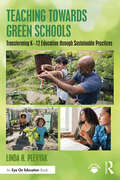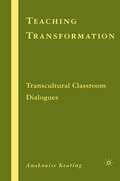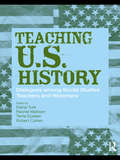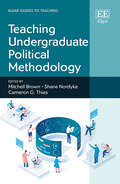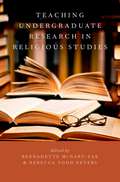- Table View
- List View
Teaching Toward Freedom: Supporting Voices and Silence in the English Classroom (Routledge Research in Teacher Education)
by Geraldine DeLucaTeaching Toward Freedom: Supporting Voices and Silence in the English Classroom promotes teaching and learning that celebrate diversity and community through the systematic integration of traditionally "non-academic" voices and mindfulness-based, contemplative practices. By examining current scholarship and discussing novels and memoirs whose power is tied to freedom of expression, this book argues that teachers should allow students to use and explore the various rhetorical registers that they bring to the classroom. Through an innovative combination of narrative, argument, and literary analysis, the book skillfully connects conversations about linguistic diversity and contemplative approaches in order to foster a compassionate space for learning in the college-level English classroom.
Teaching Toward Freedom: Supporting Voices and Silence in the English Classroom (Routledge Research in Teacher Education)
by Geraldine DeLucaTeaching Toward Freedom: Supporting Voices and Silence in the English Classroom promotes teaching and learning that celebrate diversity and community through the systematic integration of traditionally "non-academic" voices and mindfulness-based, contemplative practices. By examining current scholarship and discussing novels and memoirs whose power is tied to freedom of expression, this book argues that teachers should allow students to use and explore the various rhetorical registers that they bring to the classroom. Through an innovative combination of narrative, argument, and literary analysis, the book skillfully connects conversations about linguistic diversity and contemplative approaches in order to foster a compassionate space for learning in the college-level English classroom.
Teaching Toward the 24th Century: Star Trek as Social Curriculum (Pedagogy and Popular Culture)
by Karen AnijarTrekkie popular culture sees Star Trek as a unifying myth. Dr Anijar explores this phenomenon in light of the influences of television in children's lives, and the effects of utopian interpretations of Star Trek on teaching practice.
Teaching Toward the 24th Century: Star Trek as Social Curriculum (Pedagogy and Popular Culture)
by Karen AnijarTrekkie popular culture sees Star Trek as a unifying myth. Dr Anijar explores this phenomenon in light of the influences of television in children's lives, and the effects of utopian interpretations of Star Trek on teaching practice.
Teaching towards Democracy with Postmodern and Popular Culture Texts (Imagination and Praxis: Criticality and Creativity in Education and Educational Research)
by Patricia Paugh Tricia Kress Robert LakeThis edited volume supports implementation of a critical literacy of popular culture for new times. It explores popular and media texts that are meaningful to youth and their lives. It questions how these texts position youth as literate social practitioners. Based on theories of Critical and New Literacies that encourage questioning of social norms, the chapters challenge an audience of teachers, teacher educators, and literacy focused scholars in higher education to creatively integrate popular and media texts into their curriculum. Focal texts include science fiction, dystopian and other youth central novels, picture books that disrupt traditional narratives, graphic novels, video-games, other arts-based texts (film/novel hybrids) and even the lives of youth readers themselves as texts that offer rich possibilities for transformative literacy. Syllabi and concrete examples of classroom practices have been included by each chapter author
Teaching Towards Green Schools: Transforming K–12 Education through Sustainable Practices
by Linda H. PlevyakThis engaging and timely book showcases practical ways that PreK–12 teachers and school leaders can create and implement sustainability-focused projects and practices in their classrooms and schools, helping promote a healthy, sustainable environment and curriculum for students and leading the way towards becoming a green school. Sharing real-world case studies and detailed walk-throughs of sustainable schools in action – from Madison, Alabama, to Bali, Indonesia – author Linda H. Plevyak lays out the benefits, principles and practices of creating a sustainable school from beginner classroom projects like creating a garden, recycling and composting to more complex and school-wide initiatives like energy audits, creating an environmental management system, engaging with policy and building and leveraging community partnerships. Plevyak highlights sustainable practices that can be developed with little to no budget and focuses on those that support the development of critical thinking skills, promote project-based learning and consider the environment as a learning tool, incorporating sustainability as a natural progression of the learning process. The book outlines extensive resources teachers and schools can use to embed sustainability in their programs and curriculum, offering teachers, school leaders and policy makers the tools they need to provide this generation of students with the knowledge and skills to create a more sustainable world.
Teaching Towards Green Schools: Transforming K–12 Education through Sustainable Practices
by Linda H. PlevyakThis engaging and timely book showcases practical ways that PreK–12 teachers and school leaders can create and implement sustainability-focused projects and practices in their classrooms and schools, helping promote a healthy, sustainable environment and curriculum for students and leading the way towards becoming a green school. Sharing real-world case studies and detailed walk-throughs of sustainable schools in action – from Madison, Alabama, to Bali, Indonesia – author Linda H. Plevyak lays out the benefits, principles and practices of creating a sustainable school from beginner classroom projects like creating a garden, recycling and composting to more complex and school-wide initiatives like energy audits, creating an environmental management system, engaging with policy and building and leveraging community partnerships. Plevyak highlights sustainable practices that can be developed with little to no budget and focuses on those that support the development of critical thinking skills, promote project-based learning and consider the environment as a learning tool, incorporating sustainability as a natural progression of the learning process. The book outlines extensive resources teachers and schools can use to embed sustainability in their programs and curriculum, offering teachers, school leaders and policy makers the tools they need to provide this generation of students with the knowledge and skills to create a more sustainable world.
Teaching Transformation: Transcultural Classroom Dialogues
by A. KeatingDrawing on indigenous belief systems and recent work in critical 'race' studies and multicultural-feminist theory, Keating provides detailed step-by-step suggestions, based on her own teaching experiences, designed to anticipate and change students' resistance to social-justice issues. It offers a holistic approach to theory and practice.
Teaching Transformed: Achieving Excellence, Fairness, Inclusion, And Harmony
by Roland TharpThe social organization of teaching and learning, particularly in classrooms, has not yet been recognized as a foundational element of education. However, social constructionist views of human development, cognition, and schooling, as well as the increasing challenges of cultural and linguistic diversity, make it a vital concern for teachers, researchers, and policymakers. This book introduces the concept of educational social organization, assembles the pertinent theory and evidence, and suggests future directions for training and policy. }The four goals of school reform--academic excellence, fairness, inclusion and harmony--can be achieved simultaneously, by transforming the final common pathway of all school reform--instructional activity. Teaching Transformed is a new vision for classrooms, based on consensus research findings and unified practice prescriptions, explained and justified by new developments in sociocultural theory, and clarified by an explicit five-phase developmental guide for achieving that transformation. Teaching Transformed is both visionary and practical, both theoretical and data-driven, and determined to create effective education for all students. Professional educators, parents, and any reader concerned with saving our schools will find this book necessary to understand our current plight, and to envision a realistic means of transformation.
Teaching Transformed: Achieving Excellence, Fairness, Inclusion, And Harmony (Renewing American Schools Ser.)
by Roland TharpThe social organization of teaching and learning, particularly in classrooms, has not yet been recognized as a foundational element of education. However, social constructionist views of human development, cognition, and schooling, as well as the increasing challenges of cultural and linguistic diversity, make it a vital concern for teachers, researchers, and policymakers. This book introduces the concept of educational social organization, assembles the pertinent theory and evidence, and suggests future directions for training and policy. }The four goals of school reform--academic excellence, fairness, inclusion and harmony--can be achieved simultaneously, by transforming the final common pathway of all school reform--instructional activity. Teaching Transformed is a new vision for classrooms, based on consensus research findings and unified practice prescriptions, explained and justified by new developments in sociocultural theory, and clarified by an explicit five-phase developmental guide for achieving that transformation. Teaching Transformed is both visionary and practical, both theoretical and data-driven, and determined to create effective education for all students. Professional educators, parents, and any reader concerned with saving our schools will find this book necessary to understand our current plight, and to envision a realistic means of transformation.
Teaching Travel and Tourism 14+ (UK Higher Education OUP Humanities & Social Sciences Education OUP)
by Cliff Huggett Deborah PownallTravel and Tourism has become an integral part of many countries' economies. As a rapidly changing, multidisciplinary subject, there are many approaches to teaching it. This book brings together the theory and practice of learning for Travel and Tourism as a vocational pathway offering the educational practitioner a pedagogical framework for the delivery of their subject.Huggett and Pownall outline the vast range of programmes and qualifications you may encounter in your teaching. They also consider the skills, knowledge and understanding learners need to develop, taking into account the life experiences and aspirations of different groups of learners, and consider how these are transferable from one sub-sector to another.The range of job roles within the Travel and Tourism industry is immense and will continue to evolve. As well as private industry, the authors consider the public and voluntary sectors and look at organizations that have been set up to support and benefit tourism, taking into account policies and initiatives that stakeholders introduce.This book supports trainee and experienced teachers in developing exciting and engaging Travel and Tourism programmes for learners 14+ whether in schools, colleges, higher education or in-service training.About the Teaching 14+ seriesWritten to support the unique challenges of teaching vocational subjects, the Teaching 14+ series provides the pedagogical skills required to become a successful teacher. Alongside coverage of issues and debates, the series includes interactive exercises, case studies and activities that can be used to develop a variety of teaching and learning strategies to improve the delivery of these subjects.
Teaching, Tutoring and Training in the Lifelong Learning Sector
by Susan WallaceThis core text provides comprehensive support for pre-service and in-service trainee teachers in the Lifelong Learning Sector covering all they need to know to achieve QTLS status. Supporting trainees through all stages of their professional development, the text takes the reader through the theoretical background underpinning teaching and learning and offers practical guidance on day-to-day challenges. This fourth edition has been fully revised and updated and includes a new chapter on teaching practice with notes on observation and lesson planning. New information on behaviour management has been added to support trainees in an aspect of teaching that many find challenging.
Teaching, Tutoring and Training in the Lifelong Learning Sector
by Susan WallaceThis core text provides comprehensive support for pre-service and in-service trainee teachers in the Lifelong Learning Sector covering all they need to know to achieve QTLS status. Supporting trainees through all stages of their professional development, the text takes the reader through the theoretical background underpinning teaching and learning and offers practical guidance on day-to-day challenges. This fourth edition has been fully revised and updated and includes a new chapter on teaching practice with notes on observation and lesson planning. New information on behaviour management has been added to support trainees in an aspect of teaching that many find challenging.
Teaching, Tutoring and Training in the Lifelong Learning Sector (PDF)
by Susan WallaceThis core text provides comprehensive support for pre-service and in-service trainee teachers in the Lifelong Learning Sector covering all they need to know to achieve QTLS status.
Teaching U.S. History: Dialogues Among Social Studies Teachers and Historians
by Diana Turk Rachel Mattson Terrie Epstein Robert CohenTeaching U.S. History offers an innovative approach to social studies teaching by connecting historians to real-world social studies classrooms and social studies teachers. In an unusual, even unprecedented, dialogue between scholars and practitioners, this book weds historical theory and practice with social studies pedagogy. Seven chapters are organized around key US History eras and events from the time of slavery through the Civil Rights Movement and are complemented by detailed discussions of a particular methodological approach, including primary source analysis, oral history and more. Interviews with historians open each chapter to bring the reader into important conversations about the most cutting edge issues in U.S. history today and are followed by essays from expert teachers on the rewards and challenges of implementing these topics in the classroom. Each chapter also includes a wealth of practical resources including suggested key documents or artifacts; a lesson plan for middle school and another suitable for high school; and suggested readings and questions for further study. Teaching U.S. History is a must read for any aspiring or current teacher who wants to think critically about how to teach U.S. history and make historical discussions come alive in the school classrooms where the nation’s students learn.
Teaching U.S. History: Dialogues Among Social Studies Teachers and Historians
by Diana Turk Rachel Mattson Terrie Epstein Robert CohenTeaching U.S. History offers an innovative approach to social studies teaching by connecting historians to real-world social studies classrooms and social studies teachers. In an unusual, even unprecedented, dialogue between scholars and practitioners, this book weds historical theory and practice with social studies pedagogy. Seven chapters are organized around key US History eras and events from the time of slavery through the Civil Rights Movement and are complemented by detailed discussions of a particular methodological approach, including primary source analysis, oral history and more. Interviews with historians open each chapter to bring the reader into important conversations about the most cutting edge issues in U.S. history today and are followed by essays from expert teachers on the rewards and challenges of implementing these topics in the classroom. Each chapter also includes a wealth of practical resources including suggested key documents or artifacts; a lesson plan for middle school and another suitable for high school; and suggested readings and questions for further study. Teaching U.S. History is a must read for any aspiring or current teacher who wants to think critically about how to teach U.S. history and make historical discussions come alive in the school classrooms where the nation’s students learn.
Teaching U.S. History as Mystery
by David Gerwin Jack ZevinPresenting U.S. history as contested interpretations of compelling problems, this text offers a clear set of principles and strategies, together with case studies and "Mystery Packets" of documentary materials from key periods in American history, that teachers can use with their students to promote and sustain problem-finding and problem-solving in history and social studies classrooms. Structured to encourage new attitudes toward history as hands-on inquiry, conflicting interpretation, and myriad uncertainties, the whole point is to create a user-friendly way of teaching history "as it really is" ? with all its problems, issues, unknowns, and value clashes. Students and teachers are invited to think anew as active participants in learning history rather than as passive sponges soaking up pre-arranged and often misrepresented people and events. New in the Second Edition: New chapters on Moundbuilders, and the Origins of Slavery; expanded Gulf of Tonkin chapter now covering the Vietnam and Iraq wars; teaching tips in this edition draw on years of teacher experience in using mysteries in their classrooms.
Teaching U.S. History as Mystery
by David Gerwin Jack ZevinPresenting U.S. history as contested interpretations of compelling problems, this text offers a clear set of principles and strategies, together with case studies and "Mystery Packets" of documentary materials from key periods in American history, that teachers can use with their students to promote and sustain problem-finding and problem-solving in history and social studies classrooms. Structured to encourage new attitudes toward history as hands-on inquiry, conflicting interpretation, and myriad uncertainties, the whole point is to create a user-friendly way of teaching history "as it really is" ? with all its problems, issues, unknowns, and value clashes. Students and teachers are invited to think anew as active participants in learning history rather than as passive sponges soaking up pre-arranged and often misrepresented people and events. New in the Second Edition: New chapters on Moundbuilders, and the Origins of Slavery; expanded Gulf of Tonkin chapter now covering the Vietnam and Iraq wars; teaching tips in this edition draw on years of teacher experience in using mysteries in their classrooms.
Teaching Undergraduate Political Methodology (Elgar Guides to Teaching)
Providing expert advice from established scholars in the field of political science, this engaging book imparts informative guidance on teaching research methods across the undergraduate curriculum. Written in a concise yet comprehensive style, it illustrates practical and conceptual advice, alongside more detailed chapters focussing on the different aspects of teaching political methodology.Each chapter draws on practised teaching methods covering the what, how and when for teaching political methodology with an in-depth look at systematic research methods. The book is split into four distinct sections for undergraduate research methods education: the approach, the foundations of research design, quantitative analysis and qualitative data. All the advice is evidence-based and grounded in the science of teaching and learning (SoTL) literature from experienced, award-winning and highly recognized instructors of political methodology.Teaching Undergraduate Political Methodology will be required reading for faculty wanting to establish excellent methods for challenging subjects within the fields of political science, public administration and public policies. It will also serve as a useful resource for instructors wishing to gain greater student engagement with their courses by utilising different methods.
Teaching Undergraduate Research in Religious Studies (AAR Teaching Religious Studies)
by Bernadette McNary-Zak Rebecca Todd PetersTeaching Undergraduate Research in Religious Studies offers an introduction to the philosophy and practice of Undergraduate Research in Religious Studies and takes up several significant ongoing questions related to it. For those new to Undergraduate Research, it provides an overview of fundamental issues and pedagogical questions and practical models for application in the classroom. For seasoned mentors, the book acts as a dialogue partner on emerging issues and offers insight into pertinent questions in the field based on experience of recognized experts.
Teaching Undergraduate Science: A Guide to Overcoming Obstacles to Student Learning
by Linda C. HodgesThis book is written for all science or engineering faculty who have ever found themselves baffled and frustrated by their undergraduate students’ lack of engagement and learning. The author, an experienced scientist, faculty member, and educational consultant, addresses these issues with the knowledge of faculty interests, constraints, and day-to-day concerns in mind. Drawing from the research on learning, she offers faculty new ways to think about the struggles their science students face. She then provides a range of evidence-based teaching strategies that can make the time faculty spend in the classroom more productive and satisfying.Linda Hodges reviews the various learning problems endemic to teaching science, explains why they are so common and persistent, and presents a digest of key ideas and strategies to address them, based on the research she has undertaken into the literature on the cognitive sciences and education. Recognizing that faculty have different views about teaching, different comfort levels with alternative teaching approaches, and are often pressed for time, Linda Hodges takes these constraints into account by first offering a framework for thinking purposefully about course design and teaching choices, and then providing a range of strategies to address very specific teaching barriers – whether it be students’ motivation, engagement in class, ability to problem solve, their reading comprehension, or laboratory, research or writing skills.Except for the first and last chapters, the other chapters in this book stand on their own (i.e., can be read in any order) and address a specific challenge students have in learning and doing science. Each chapter summarizes the research explaining why students struggle and concludes by offering several teaching options categorized by how easy or difficult they are to implement. Some, for example, can work in a large lecture class without a great expenditure of time; others may require more preparation and a more adventurous approach to teaching. Each strategy is accompanied by a table categorizing its likely impact, how much time it will take in class or out, and how difficult it will be to implement.Like scientific research, teaching works best when faculty start with a goal in mind, plan an approach building on the literature, use well-tested methodologies, and analyze results for future trials. Linda Hodges’ message is that with such intentional thought and a bit of effort faculty can succeed in helping many more students gain exciting new skills and abilities, whether those students are potential scientists or physicians or entrepreneurs. Her book serves as a mini compendium of current research as well as a protocol manual: a readily accessible guide to the literature, the best practices known to date, and a framework for thinking about teaching.
Teaching Undergraduate Science: A Guide to Overcoming Obstacles to Student Learning
by Linda C. HodgesThis book is written for all science or engineering faculty who have ever found themselves baffled and frustrated by their undergraduate students’ lack of engagement and learning. The author, an experienced scientist, faculty member, and educational consultant, addresses these issues with the knowledge of faculty interests, constraints, and day-to-day concerns in mind. Drawing from the research on learning, she offers faculty new ways to think about the struggles their science students face. She then provides a range of evidence-based teaching strategies that can make the time faculty spend in the classroom more productive and satisfying.Linda Hodges reviews the various learning problems endemic to teaching science, explains why they are so common and persistent, and presents a digest of key ideas and strategies to address them, based on the research she has undertaken into the literature on the cognitive sciences and education. Recognizing that faculty have different views about teaching, different comfort levels with alternative teaching approaches, and are often pressed for time, Linda Hodges takes these constraints into account by first offering a framework for thinking purposefully about course design and teaching choices, and then providing a range of strategies to address very specific teaching barriers – whether it be students’ motivation, engagement in class, ability to problem solve, their reading comprehension, or laboratory, research or writing skills.Except for the first and last chapters, the other chapters in this book stand on their own (i.e., can be read in any order) and address a specific challenge students have in learning and doing science. Each chapter summarizes the research explaining why students struggle and concludes by offering several teaching options categorized by how easy or difficult they are to implement. Some, for example, can work in a large lecture class without a great expenditure of time; others may require more preparation and a more adventurous approach to teaching. Each strategy is accompanied by a table categorizing its likely impact, how much time it will take in class or out, and how difficult it will be to implement.Like scientific research, teaching works best when faculty start with a goal in mind, plan an approach building on the literature, use well-tested methodologies, and analyze results for future trials. Linda Hodges’ message is that with such intentional thought and a bit of effort faculty can succeed in helping many more students gain exciting new skills and abilities, whether those students are potential scientists or physicians or entrepreneurs. Her book serves as a mini compendium of current research as well as a protocol manual: a readily accessible guide to the literature, the best practices known to date, and a framework for thinking about teaching.
Teaching Undergraduates (Educational Psychology Series)
by Roger L. DominowskiThis practical guide is designed to help college teachers plan their undergraduate courses and deliver high-quality instruction. The book's theme is that teaching is a creative, decision-making, idea-testing enterprise whose purpose is to facilitate student learning in all of its facets. Its goal is to help instructors understand the multiple kinds of learning taking place in their courses so that they can select, devise, evaluate, and modify teaching techniques to improve their effectiveness. Based on research on human learning, memory, thinking, and problem solving, as well as studies of teaching and less-formal reports of teaching practices, the book offers concrete advice about all aspects of college teaching. *Part I is devoted to course planning. It outlines the many decisions instructors face in defining a course as their own and discusses the larger issues that shape a course and constrain some specific choices. Selecting course content, choosing learning goals, deciding how to pace a course, and scheduling tests are some of these issues. A workable timetable for preparing a course is included. *Part II is a mini-course on human learning, memory, and thinking. It provides the conceptual foundation for making teaching decisions, for selecting instructional strategies, and especially for inventing new techniques that might particularly fit a specific course. *Part III deals with the "nitty-gritty" of college teaching, including how to choose a textbook; lecturing and conducting classroom discussions; types and purposes of writing assignments, and how to structure and evaluate them; dealing with plagiarism; strengths and weaknesses of different types of tests, the relation of tests to learning goals, and guidelines for constructing good tests; and grading systems. *Part IV addresses professional and ethical issues of importance and consequence to instructors. New college instructors, more experienced faculty who would like to reflect on their teaching practices and consider making some changes, and teaching assistants will all find this book relevant and useful.
Teaching Undergraduates (Educational Psychology Series)
by Roger L. DominowskiThis practical guide is designed to help college teachers plan their undergraduate courses and deliver high-quality instruction. The book's theme is that teaching is a creative, decision-making, idea-testing enterprise whose purpose is to facilitate student learning in all of its facets. Its goal is to help instructors understand the multiple kinds of learning taking place in their courses so that they can select, devise, evaluate, and modify teaching techniques to improve their effectiveness. Based on research on human learning, memory, thinking, and problem solving, as well as studies of teaching and less-formal reports of teaching practices, the book offers concrete advice about all aspects of college teaching. *Part I is devoted to course planning. It outlines the many decisions instructors face in defining a course as their own and discusses the larger issues that shape a course and constrain some specific choices. Selecting course content, choosing learning goals, deciding how to pace a course, and scheduling tests are some of these issues. A workable timetable for preparing a course is included. *Part II is a mini-course on human learning, memory, and thinking. It provides the conceptual foundation for making teaching decisions, for selecting instructional strategies, and especially for inventing new techniques that might particularly fit a specific course. *Part III deals with the "nitty-gritty" of college teaching, including how to choose a textbook; lecturing and conducting classroom discussions; types and purposes of writing assignments, and how to structure and evaluate them; dealing with plagiarism; strengths and weaknesses of different types of tests, the relation of tests to learning goals, and guidelines for constructing good tests; and grading systems. *Part IV addresses professional and ethical issues of importance and consequence to instructors. New college instructors, more experienced faculty who would like to reflect on their teaching practices and consider making some changes, and teaching assistants will all find this book relevant and useful.
Teaching University Students with Autism Spectrum Disorder: A Guide to Developing Academic Capacity and Proficiency
by Kim Draisma Kimberley McMahon-ColemanDrawing on the latest research, this book offers practical strategies for supporting students with Autism Spectrum Disorder (ASD) in tertiary education. By looking at common issues faced by students with ASD, teaching and support staff will better understand how to help students develop vital skills needed for academic success.



